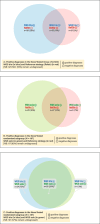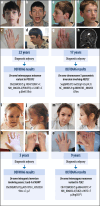Genome sequencing for the diagnosis of intellectual disability as a paradigm for rare diseases in the French healthcare setting: the prospective DEFIDIAG study
- PMID: 41044778
- PMCID: PMC12495801
- DOI: 10.1186/s13073-025-01527-4
Genome sequencing for the diagnosis of intellectual disability as a paradigm for rare diseases in the French healthcare setting: the prospective DEFIDIAG study
Abstract
Background: Intellectual disability (ID) is the leading cause of patient referral to medical genetic departments in French academic hospitals. Whole genome sequencing (WGS) as a first diagnostic approach is expected to achieve a higher diagnostic yield than the French national reference strategies (RefStrategy) (fragile X expansion testing, chromosomal microarray analysis, and 44 ID genes panel), given its broad and more homogeneous coverage, its ability to identify copy number, structural and intergenic/deep intronic events.
Methods: DEFIDIAG is a national, prospective pilot investigation, carried out in the framework of the French initiative for genomic medicine (Plan France Médecine Génomique 2025), aimed at comparing the diagnostic yield of WGS trio analysis (WGS-trio) (index case, father, mother) with the RefStrategy in real-life conditions of clinical and laboratory workflows. Both strategies were applied in a blinded fashion in 1239 ID probands (50% were already-tested, 50% were never-tested) with no definitive genetic diagnosis. Among them, a subgroup of 187 patients were randomized to undergo WGS-solo (proband only) in addition to WGS-trio and RefStrategy.
Results: Four hundred forty two likely pathogenic/pathogenic single-nucleotide variants were identified (for 231 genes) as well as 171 variants of uncertain significance warranting clinical or functional reassessment for a potential reclassification (VUS +) (for 142 genes), 79 likely pathogenic/pathogenic copy number variants and 10 likely pathogenic/pathogenic structural variants. The diagnostic yield for likely pathogenic/pathogenic variants increased from 17.3% with the RefStrategy to 41.9% with WGS-trio in the never-tested patient cohort. An increase of 13.9% was observed in all categories by adding the VUS + , thus raising the yield to 56% for WGS-trio. Overall, WGS-solo enabled the identification of likely pathogenic/pathogenic variants in 29.9% of cases (increasing to 41.1% when including VUS +) compared to 21.9% with the RefStrategy. In addition, following recent reports of de novo variants in the non-coding spliceosomal RNU4-2 gene as a common cause of ID, this gene was subsequently analyzed, leading to the identification of pathogenic de novo variants in 7 patients.
Conclusions: As a first line test for ID diagnosis, WGS (including for solo situations) proved to be more effective than the reference strategy, in the context of real-life hospital settings in France.
Trial registration: Prospectively registered with ClinicalTrials.gov under the identifier NCT04154891 (07/11/2019).
Keywords: Centers of expertise; Diagnostic yields; Intellectual disability; Multidisciplinary meetings; Real-life hospital setting; Short-read sequencing; Solo; Trio; Whole genome sequencing (WGS).
© 2025. The Author(s).
Conflict of interest statement
Declarations. Ethics approval and consent to participate: The DEFIDIAG study was conducted in accordance with the Declaration of Helsinki and its amendments. The protocol was approved by the Ethics Committee Sud Méditerranée I and the French data privacy commission (CNIL, authorization 919361). Consent for publication: Written informed consent to participate was obtained from each participant. Written parental consent was obtained for the publication of patient photographs included in this article. Competing interests: The authors declare no competing interests.
Figures






References
-
- Wright CF, Sharp LN, Jackson L, Murray A, Ware JS, MacArthur DG, et al. Guidance for estimating penetrance of monogenic disease-causing variants in population cohorts. Nat Genet. 2024. 10.1038/s41588-024-01842-3. - PubMed
Publication types
MeSH terms
Associated data
LinkOut - more resources
Full Text Sources
Medical
Research Materials

